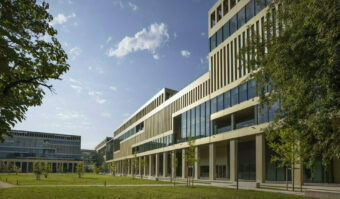
So far, the importance of digitalisation in business has been discussed on multiple occasions. This time, we aim to focus on building digitalisation and how it can help building owners and maintenance teams make the right decisions and reach their sustainability goals.
This is how Miloš Vuksanović, Sales Director for Commercial and Industrial Buildings, Serbia and Montenegro, Schneider Electric, starts his story about the importance of open BMS platforms and connected smart buildings. EcoStruxure™ Building Operation, as part of the EcoStruxure™ Building solution, is such a platform. In the anniversary year — 20 years of Schneider Electric’s operation here, Miloš Vuksanović talks about the significance of meeting sustainability goals and ways to achieve them.
“Our experience in industrial optimisation has confirmed the importance of openness, connectivity and interoperability of platforms, whose functions allow machines to work together in resolving the most complex issues organisations encounter on a daily basis”, explains Vuksanović at the beginning, add that these features are equally important for modern buildings and, as such, are an example of how to achieve zero CO₂ emission.
IN FOCUS:
- PERFECT TIMING AND THE RIGHT PARTNER FOR BUILDING A SOLAR POWER PLANT
- ENVIRONMENTAL PROBLEMS CAN ONLY BE SOLVED THROUGH A JOINT EFFORT
- SIEMENS — CREATING AN ENVIRONMENT THAT CARES
“To keep global warming at 1.5 °C, it is vital to reduce GHG emission to 45 per cent by 2030 and reach net zero by 2050. Buildings emit nearly 40 per cent of CO₂, and building owners and managers have to find a way to minimise CO₂ emission as soon as possible.” Vuksanović refers to the Paris Agreement.

Schneider Electric believes that new and existing buildings must focus on modernisation, including their transformation to fully electric and fully digital. According to him, it means turning all fossil-fuel-based consumption — such as heating — into a more efficient electric methodology. It also means that with digitalization we receive data to use further for a deeper insight and control of buildings, costs, and efficiency.
Explaining how it functions, Vuksanović says that everything is based on collecting information and the use of automation, acting unanimously to achieve these ambitious goals. In that respect, he points out several items requiring it:
- Systems in a building that communicate mutually — when all systems of a building that exchange information are really integrated and connected, the building maintenance team is enabled to make better decisions.
- The flexibility of a system to adapt and respond to the needs of owners, tenants, and society as a whole today, as well as in the future.
- Achievement of the full potential of all available data.
“New generations of the Building Management System respond to all these needs, and their implementation results in developing buildings of the future. A modern open BMS offers connectivity, interoperability and intelligence. It helps all devices in a building be connected into a shared control centre for managing all operations”, Miloš Vuksanović underlines.
He points to the solution of new generation smart buildings available today, including one from Schneider Electric’s portfolio.
Prepared by: Milica Marković
Read the story in the new issue of the Energy portal Magazine Waste Management.



